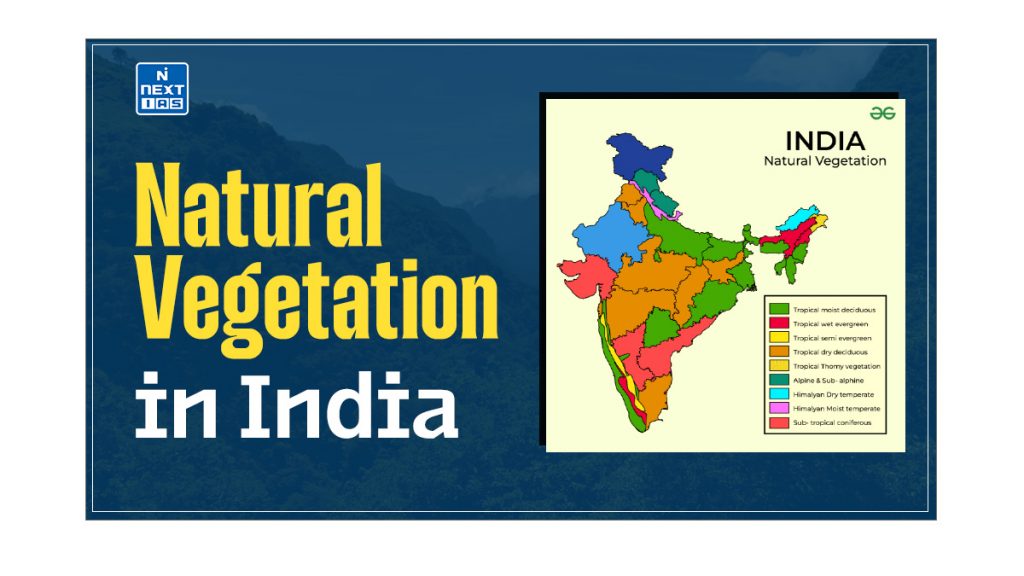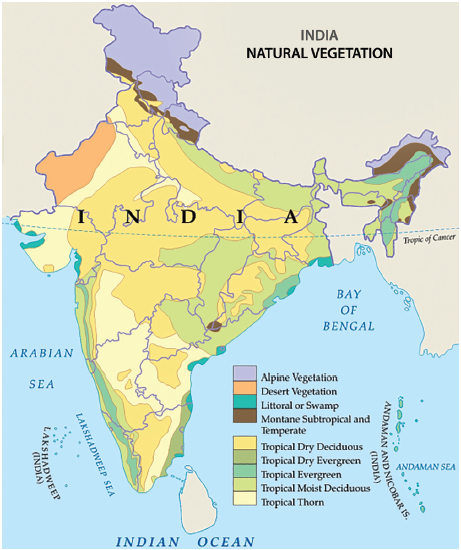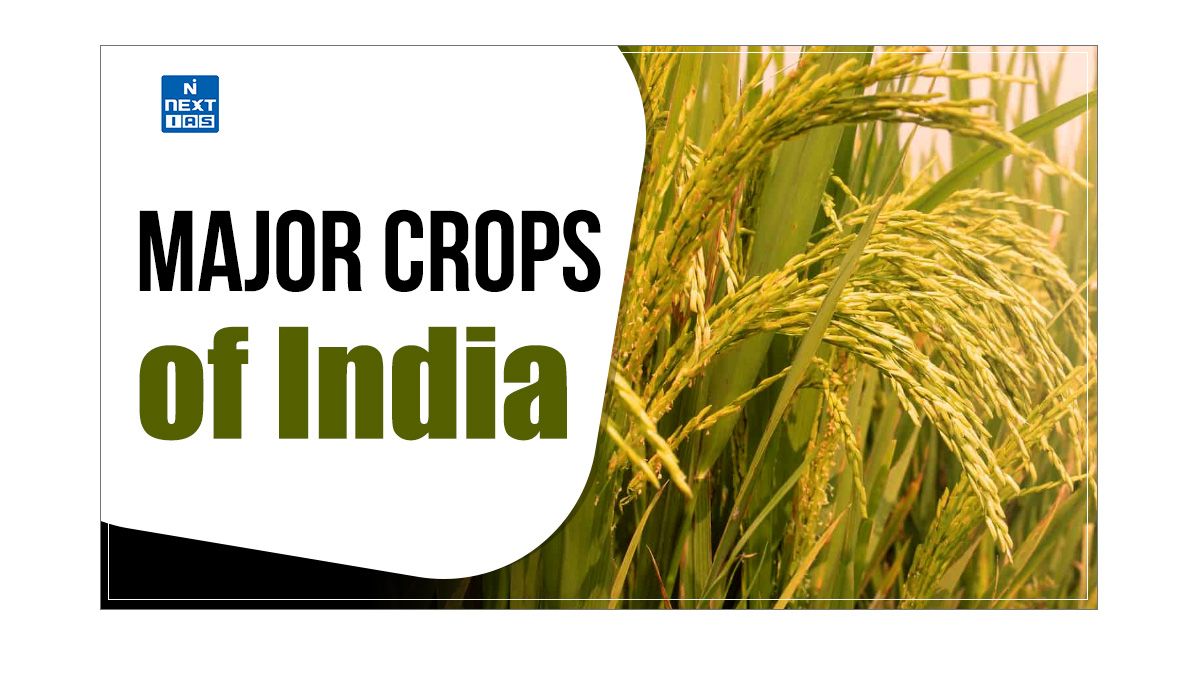
Natural Vegetation in India encompasses a diverse range of plant communities adapted to various climatic, soil, and topographical conditions across the country. Its significance lies in its contribution to biodiversity, ecological balance, and the provision of essential resources and services. This article aims to study in detail the classification, types, and significance of natural vegetation in India, offering insights into its impact on the environment and economy.
About Natural Vegetation in India
- Climate, soil and topography are the major factors that influence the Natural Vegetation of a place.
- The main climatic factors are rainfall and temperature.
- The amount of annual rainfall has a significant bearing on the types of vegetation.
- Temperature is the primary factor in the Himalayas and other hilly regions, with an elevation of more than 900 meters.
- As the temperature falls with altitude in the Himalayan regions, the vegetal cover changes with altitude from tropical to sub-tropical, temperate, and finally alpine.
- Soil is an equally determining factor in a few regions.
- For instance, the soil plays an important role in mangrove forests and swamp forests.
| Annual Rainfall | Type of Vegetation |
|---|---|
| 200 cm or more | Evergreen Rain Forests |
| 100 to 200 cm | Monsoon Deciduous Forests |
| 50 to 100 cm | Drier Deciduous or Tropical Savanna |
| 25 to 50 cm | Dry Thorny Scrub (Semi-arid) |
| Below 25 cm | Desert (Arid) |

Types of Natural Vegetation in India
The main types of natural vegetation in India includes:
- Forest Vegetation – It is categorised into three types:
- Tropical Rainforests – These are the dense forests found near the equator with high rainfall, i.e. the Amazon Rainforest.
- Temperate Forests – These are found in temperate zones and experience seasonal changes, i.e. deciduous forests in North America and Europe.
- Boreal Forests (Taiga) – These are coniferous forests found in high-latitude areas, i.e. Canada and Russia.
- Grassland Vegetation – It is categorised into two types:
- Tropical Grasslands (Savannas) – These are found in regions with a warm climate and distinct wet and dry seasons, i.e. the African Savannas.
- Temperate Grasslands – These are found in temperate regions with moderate rainfall, i.e. the Prairies in North America and the Steppes in Eurasia.
- Desert Vegetation – It is categorised into two types:
- Hot Deserts – These are sparse vegetation adapted to arid conditions, i.e. the cacti and shrubs in the Sahara Desert.
- Cold Deserts – These are found in high-altitude or high-latitude regions with cold temperatures and low precipitation, i.e. the vegetation in the Gobi Desert.
- Tundra Vegetation – These are found in polar regions with cold climates and permafrost. It is limited to mosses, lichens, and low shrubs, i.e. the Arctic tundra.
- Mountain Vegetation – This vegetation varies with altitude, including mixed forests at lower elevations, alpine meadows at higher elevations, and tundra-like conditions near the peaks.
Classification of Natural Vegetation in India
Natural vegetation in India can be broadly classified into several categories based on climatic conditions, soil types, and geographical factors:
- On the Basis of Rainfall Distribution,
- On the Basis of Administration, and
- On the Basis of Ownership.
All these classifications of Natural Vegetation in India have been discussed in detail in the following section.
On the Basis of Rainfall Distribution
The classification of Natural Vegetation in India is primarily based on spatial and annual variations in rainfall. However, temperature, soil, and topography also play essential roles. India’s vegetation can be divided into five main types and 16 sub-types, as given below:
Moist Tropical Forests
- Tropical Wet Evergreen, Tropical Semi-Evergreen, Tropical Moist Deciduous, Littoral, and Swamp Forest types.\
Dry Tropical Forests
- Tropical Dry Evergreen, Tropical Dry Deciduous, and Tropical Thorn.
Montane Subtropical Forests
- Subtropical Broad-Leaved Hill Forests, Subtropical Moist Hill Forests (Pine), and Subtropical Dry Evergreen Forests.
Montane Temperate Forests (MTF)
- The various forms of MTF are Montane Wet Temperate, Himalayan Moist Temperate, and Himalayan Dry Temperate Forests.
Alpine Forests
- Sub-Alpine, Moist Alpine Scrub, and Dry Alpine Scrub are forms of Alpine forests.
Read our detailed article on Types of Forests in India.
On the Basis of Administration
The classification of natural vegetation in India can also be organised based on administrative divisions. This approach considers the management and protection of forests and vegetation at different levels of government oversight.
Reserved Forests
- These forests are under the government’s direct supervision, and public entry is prohibited, even for timber collection or cattle grazing.
- About 53% of the total forest area falls in this category.
Protected Forests
- The government looks after these forests. However, local people can collect fuelwood/timber and graze their cattle without causing severe damage to the forests.
- These forests occupy about 29% of the country’s total forest area.
Unclassified Forests
- Unclassified forests are those in which tree-cutting and cattle grazing are not restricted.
- About 18.1% of the country’s total forest area falls under this category.
On the Basis of Ownership
The classification of natural vegetation in India based on ownership can be organised into the following categories:
State Forests
- These are under the full control of the government (state/central) and include almost all the country’s important forest areas.
- They constitute about 94 per cent of the country’s total forest area.
Commercial Forests
- These forests are owned and administered by local bodies (municipal corporations, municipal boards, town areas, district boards, and village panchayats).
- They constitute about 5 per cent of the country’s total forest area.
Private Forests
- These are under private ownership and cover slightly more than one per cent of the country’s total forest area.
Forest Products
Forests constitute one of India’s major natural resources. They are used for various purposes and form an essential sector of the Indian economy. They produce many woods used as timber, fuel, and industrial raw materials. They also provide many other things like bamboo, canes, herbs, etc. Forest products in India are classified into Major products and Minor products:
Major Products
- The major forest products are timber, smallwood, and fuelwood, including charcoal. Indian forests produce about 5,000 species of wood, of which about 450 are commercially valuable.
- Forests meet about 40% of the country’s energy needs, including more than 80% of the rural energy requirements.
- Indian forests produce both hard and soft woods. Hardwoods include important species such as teak, mahogany, rosewood, ironwood, ebony, sal, greenheart, kikar, email, etc.
- These woods are used for furniture, wagons, tools, etc.
- Softwoods include deodar, poplar, pine, fir, cedar, balsam, etc. They are light, strong, fairly durable, and easy to work with, making them useful for construction timbers.
- They also provide useful raw materials for making paper pulp.
Minor Products
- Minor forest products include all products obtainable from forests other than wood and thus comprise products of vegetable and animal origin, such as grasses, bamboo and canes, tans and dyes, oils, gums and resins, fibres and flosses, leaves, drugs, spices and poisons, edible products (fruit, flowers, leaves, roots, etc.), and animal products (lac, honey, wax, silk, etc.).
Indirect Use of Forests
- Forests are also responsible for many indirect uses, such as:
- Checking soil erosion.
- Regulating the flow of rivers.
- Reducing the frequency and intensity of floods.
- Checking the spread of deserts.
- Adding to soil fertility.
- Ameliorating the extremes of climate.
Significance of Natural Vegetation in India
- Biodiversity Conservation – Natural vegetation in India provides habitat for a wide variety of flora and fauna, contributing to preserving India’s rich biodiversity.
- Climate Regulation – Forests and vegetation play a crucial role in regulating the climate by absorbing carbon dioxide, maintaining humidity, and influencing local and regional weather patterns.
- Soil Protection – Vegetation stabilises the soil with its root systems, helping prevent soil erosion, maintain soil fertility, and reduce the risk of landslides.
- Water Cycle Regulation – Forests influence the water cycle by regulating river flows, replenishing groundwater, and reducing the frequency and intensity of floods.
- Economic Resources – Natural vegetation in India is a source of various resources such as timber, fuelwood, medicinal plants, and non-timber products like bamboo, honey, and resins, which are vital for the livelihoods of many communities.
Conclusion
Natural vegetation in India reflects the country’s diverse climatic and geographical conditions. The forests and vegetation not only support a wide array of wildlife and contribute to ecological balance but also provide essential resources and services that sustain human life. Understanding these classifications helps in effective management and conservation efforts, ensuring that India’s natural resources are preserved for future generations while meeting the present-day needs of its population.
Frequently Asked Questions (FAQs)
What are the types of Natural Vegetation in India?
The major types of Natural Vegetation in India are:
– Tropical Rainforests
– Tropical Deciduous Forests
– Tropical Thorn Forests
– Montane Forests
– Mangrove Forests
– Desert Vegetation
– Alpine and Sub-Alpine Vegetation.
What is Natural Vegetation?
Natural vegetation refers to the plant life that grows naturally in a region without human intervention, shaped by the local climate, soil, and ecological conditions.






